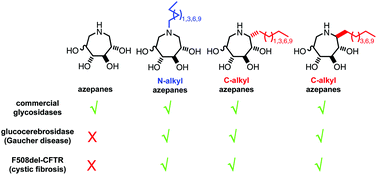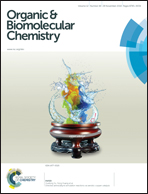N- and C-alkylation of seven-membered iminosugars generates potent glucocerebrosidase inhibitors and F508del-CFTR correctors†
Abstract
The glycosidase inhibitory properties of synthetic C-alkyl and N-alkyl six-membered iminosugars have been extensively studied leading to therapeutic candidates. The related seven-membered iminocyclitols have been less examined despite the report of promising structures. Using an in house ring enlargement/C-alkylation as well as cross-metathesis methodologies as the key steps, we have undertaken the synthesis and biological evaluation of a library of fourteen 2C- and eight N-alkyl tetrahydroxylated azepanes starting from an easily available glucopyranose-derived azidolactol. Four, six, nine and twelve carbon atom alkyl chains have been introduced. The study of two distinct D-gluco and L-ido stereochemistries for the tetrol pattern as well as R and S configurations for the C-2 carbon bearing the C-alkyl chain is reported. We observed that C-alkylation of the L-ido tetrahydroxylated azepane converts it from an α-L-fucosidase to a β-glucosidase and β-galactosidase inhibitor while N-alkylation of the D-gluco iminosugar significantly improves its inhibition profile leading to potent β-glucosidase, β-galactosidase, α-L-rhamnosidase and β-glucuronidase inhibitors whatever the stereochemistry of the alkyl chain. Interestingly, the N-alkyl chain length usually parallels the azepane inhibitor potency as exemplified by the identification of a potent glucocerebrosidase inhibitor (Ki 1 μM) bearing a twelve carbon atom chain. Additionally, several C-alkyl azepanes demonstrated promising F508del-CFTR correction unlike the parent tetrahydroxyazepanes. None of the C-alkyl and N-alkyl azepanes did inhibit ER α-glucosidases I or II.


 Please wait while we load your content...
Please wait while we load your content...